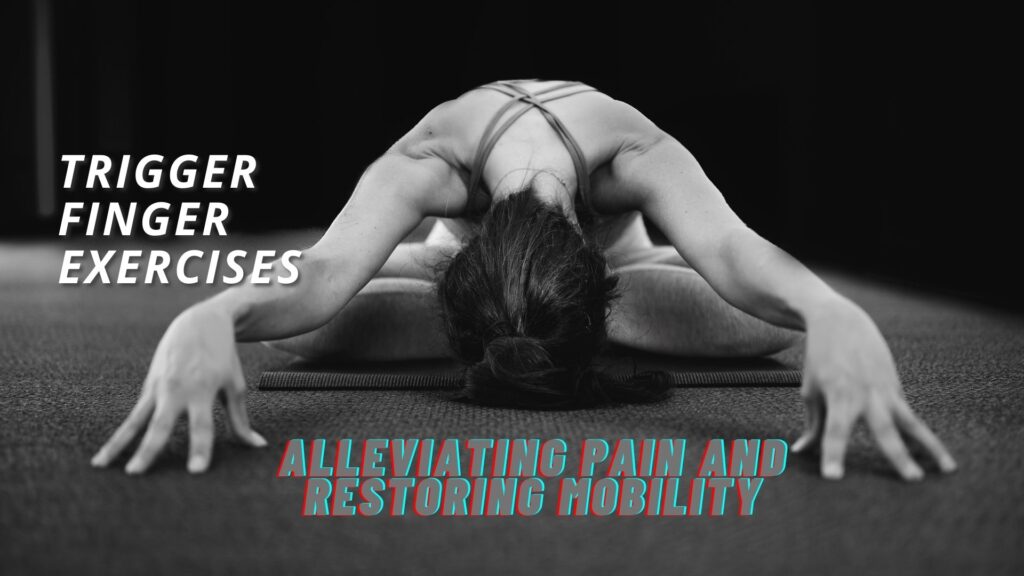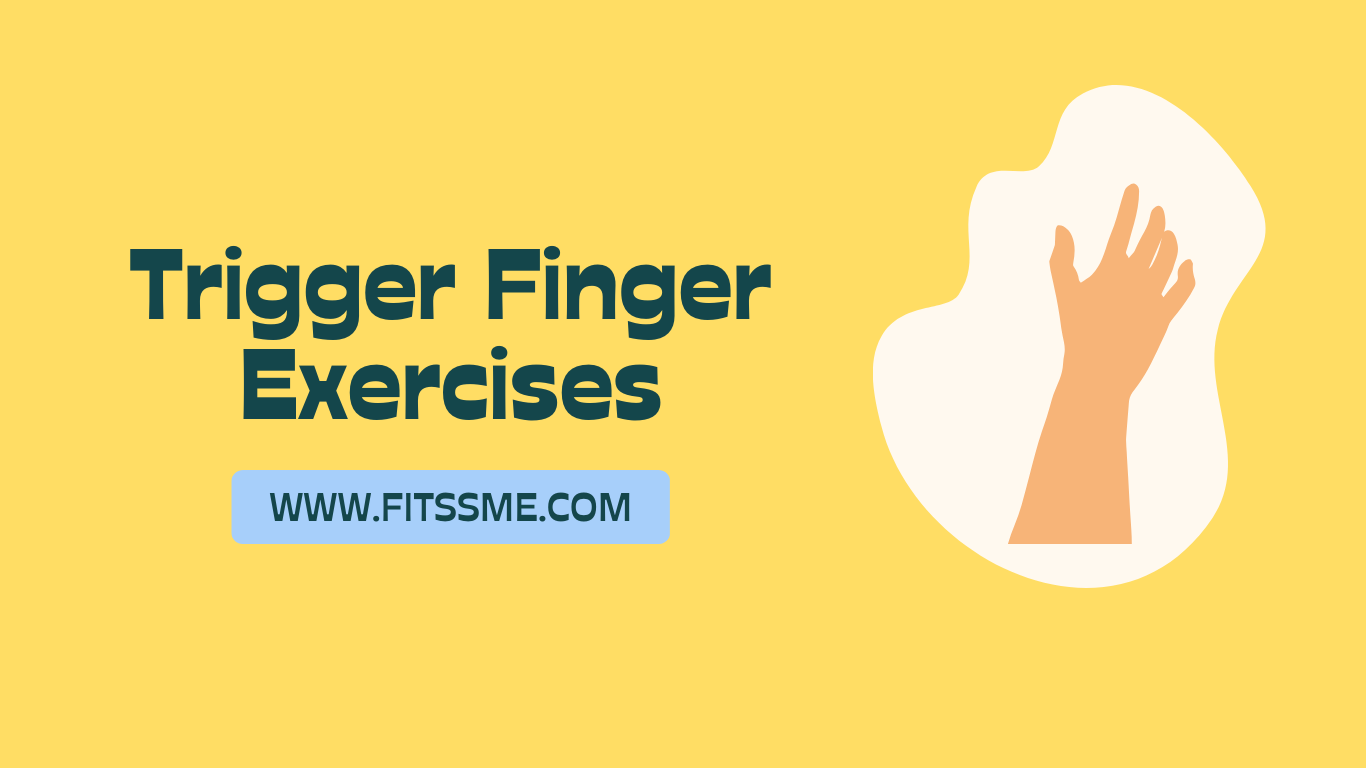Trigger Finger Exercises: Alleviating Pain and Restoring Mobility

Introduction
It can be painful and frustrating to have trigger finger. This condition, medically known as stenosing tenosynovitis, occurs when the tendons in your fingers become inflamed or irritated, making it difficult to bend or straighten them. While trigger finger often requires medical intervention, incorporating specific exercises into your daily routine can play a significant role in alleviating pain, improving flexibility, and restoring mobility. In this article, we will explore a range of trigger finger exercises designed to help you regain control of your fingers and enhance your overall hand function.
1. Understanding the Trigger Finger
1.1 What Is a Trigger Finger?
Trigger finger is a condition characterized by the inflammation or irritation of the flexor tendons in your fingers. When the tendons become swollen, they may no longer glide smoothly through the sheath surrounding them, causing your finger to get stuck in a bent or straight position. The affected finger often snaps or pops when attempting to move it, resembling the action of pulling a trigger, hence the name “trigger finger.”
1.2 Causes and Risk Factors
The exact cause of trigger finger is not always clear, but certain factors increase the likelihood of developing this condition. These include repetitive hand motions, such as gripping or grasping objects, as well as medical conditions like rheumatoid arthritis, diabetes, or hypothyroidism. Additionally, trigger finger is more prevalent in women and individuals aged 40 and older.
2. The Importance of Exercise for Trigger Finger
Incorporating exercises into your daily routine can be beneficial for managing trigger finger symptoms and improving hand function. Exercise helps increase blood flow to the affected area, reduce stiffness, and strengthen the muscles and tendons surrounding the fingers. By consistently performing trigger finger exercises, you can alleviate pain, promote healing, and regain mobility.
3. Precautions and Considerations
Before starting any exercise regimen for trigger finger, it’s important to consult with your healthcare provider or a hand therapist. They can assess your condition and provide specific recommendations based on your individual needs. It’s crucial to listen to your body and not push through any exercises that cause pain or discomfort. Start slowly and gradually increase the intensity and duration of your exercises as your symptoms improve.

4. Trigger Finger Exercises
4.1 Warm-Up Exercises
Warm-up exercises help prepare your fingers and hands for the upcoming workout. Perform these exercises before moving on to the more targeted exercises for the trigger finger.
- Finger Circles: Gently rotate your fingers in a circular motion, starting from your thumb and moving to your pinky finger. Make 10 circles in one direction, then 10 more in the alternate.
- Fist Openings and Closings: Slowly open your hand, spreading your fingers as wide as possible, and then make a fist by curling your fingers inward. Repeat this movement 10 times.
4.2 Range-of-Motion Exercises
Range-of-motion exercises help improve flexibility and restore full movement in your fingers.
- Finger Flexion and Extension: Start with your fingers extended straight. Gradually bend them, bringing the tips of your fingers towards your palm. Hold for a few seconds, then slowly extend your fingers back to the starting position. Repeat 10 times.
- Thumb Touches: Touch the tip of each finger to your thumb one by one, starting with your index finger and moving to your pinky finger. Repeat this exercise three times.
4.3 Strengthening Exercises
Strengthening exercises aim to improve the strength and endurance of the muscles and tendons in your hands and fingers.
- Finger Squeezes: Hold a soft ball or stress ball in your hand and squeeze it tightly for 5 seconds. Relax your grip and repeat 10 times with each hand.
- Rubber Band Extensions: Place a rubber band around your fingers and spread them apart against the resistance of the band. Repeat this exercise 10 times.
4.4 Stretching Exercises
Stretching exercises help improve flexibility and reduce stiffness in the affected fingers.
- Tabletop Stretch: Place your affected hand on a table, palm down, with your fingers pointing towards you. Gently press your palm against the table while keeping your fingers straight. Hold this stretch for 20 seconds and repeat three times.
- Finger Fan: Spread your fingers apart as wide as possible, like a fan. After a brief period of holding this position, relax.
4.5 Finger Tendon Glides
Finger tendon glides promote smooth tendon movement and can be especially helpful for alleviating trigger finger symptoms.
- Straight Fist Glide: Begin with your hand in a fist. Slowly and gradually, open your hand until your fingers are straight, then close your hand back into a fist. Repeat this gliding motion 10 times.
- Hook Fist Glide: Start with your hand in a hook position, with your fingers curled in. Extend your fingers one by one until they are straight, then curl them back into a hook position. Perform 10 gliding movements.
5. Lifestyle Changes to Support Recovery
In addition to exercises, certain lifestyle modifications can aid in the recovery and management of trigger finger.
- Rest and Avoidance of Overuse: Give your hand ample rest and avoid activities that aggravate your symptoms, especially those involving repetitive finger movements.
- Ergonomic Modifications: Make ergonomic adjustments to your workspace or daily activities to reduce strain on your hands and fingers. This may include using supportive devices or tools with larger handles.
- Cold and Heat Therapy: Apply cold packs to reduce inflammation and heat packs to promote circulation and relaxation in the affected area.
6. Seeking Professional Help
While exercises and lifestyle changes can be effective for managing trigger finger, it’s essential to consult a healthcare professional for a comprehensive evaluation and guidance tailored to your specific condition. They may recommend additional treatments, such as splinting, medication, or, in severe cases, surgical intervention.
Conclusion
Incorporating trigger finger exercises into your daily routine, along with adopting appropriate lifestyle modifications, can be instrumental in relieving pain, improving mobility, and restoring hand function. However, it’s important to consult with your healthcare provider or a hand therapist to ensure the exercises are suitable for your condition. By taking proactive steps and adhering to a consistent exercise regimen, you can regain control of your fingers and enjoy a more comfortable and active life.
FAQs
1. Can trigger finger exercises cure the condition? Trigger finger exercises can help alleviate symptoms and improve hand function, but they may not cure the condition entirely. It’s important to consult with a healthcare professional for a comprehensive evaluation and treatment plan.
2. How often should I perform trigger finger exercises? It’s recommended to perform trigger finger exercises at least once a day, gradually increasing the frequency and intensity as tolerated. However, consult with your healthcare provider for personalized recommendations.
3. Are trigger finger exercises suitable for everyone? While trigger finger exercises can benefit many individuals, it’s crucial to consult with a healthcare professional or hand therapist to determine if they are appropriate for your specific condition.
4. Can trigger-finger exercises prevent surgery? In some cases, trigger finger exercises and other conservative treatments may eliminate the need for surgery. However, the effectiveness of non-surgical approaches depends on the severity and progression of the condition. Consult with a healthcare professional for personalized advice.
5. How long does it take to see improvement with trigger finger exercises? The timeframe for improvement varies from person to person. Consistency and adherence to the exercise regimen, along with other recommended treatments, play a crucial role in achieving positive outcomes. If symptoms persist or worsen, consult with your healthcare provider.

